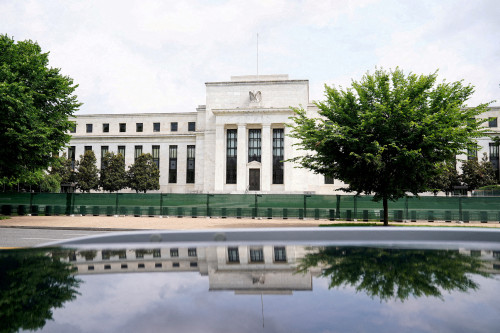By Indradip Ghosh
BENGALURU (Reuters) -A Federal Reserve interest rate cut in September, the first this year, followed perhaps by another before year-end remains the base forecast for most economists polled by Reuters amid rising concerns about the health of the world’s biggest economy.
U.S. inflation is rising again, with more upward pressure expected from President Donald Trump’s tariffs, and there have been big downward revisions to hiring figures over recent months that suggest the job market is weakening.
Trump has berated Fed Chair Jerome Powell over his reluctance to cut rates. And at the July meeting there was clear divergence from the steady rates position among a minority of Federal Open Market Committee members.
Alongside simmering doubts over the Fed’s independence from political interference and declining reliability of economic data, it has become more difficult for economists to make predictions with great conviction.
August is not typically a month for big forecast changes either. Many are waiting for the next round of inflation and jobs data, as well as a speech from Powell, his last at the Fed’s annual Jackson Hole conference held this month as his term as Fed chief ends in May.
Economists are broadly sticking to a more cautious outlook than interest rate futures traders, whose pricing suggests a near-certainty of a September cut and strong likelihood of another, and the possibility of a third by year-end.
A 61% majority, 67 of 110, predicted the Fed would lower its benchmark interest rate by 25 basis points to 4.00%-4.25% on September 17 for the first time this year, up from 53% in July’s survey. One forecast a 50 basis point move.
The remaining 42 said the Fed would hold rates again.
“We think that market participants are excessively confident in a September cut, as they are misinterpreting both the FOMC’s assessment of labor market conditions and its reaction function,” wrote economists at Barclays in a note.
“In our view, the main question is not so much about whether the Fed needs to ease policy to lean against job declines, but whether the situation warrants cuts on the grounds that the balance of risks has shifted away from inflation and toward the full employment mandate.”
Over 60% of respondents, 68 of 110, predicted there would be either one or two rate cuts this year, broadly unchanged from last month. But there was no consensus on where the federal funds rate would be at end-2025.
A near-80% majority of economists who answered an extra question, fewer than the usual sample, said the inflation impact from tariffs would be temporary.
A 68% majority also expected no serious erosion of the Fed’s independence during the remainder of Powell’s term.
Inflation forecasts were broadly unchanged from last month, averaging above the Fed’s 2% target through at least 2027.
The unemployment rate was expected to be around the current 4.2% or slightly above over the next few years, suggesting economists have not yet fully responded to the recent sharp downward revisions to hiring and may do so in the next poll if August jobs data are also weak.
“We come down on the side of thinking the Fed would prefer to retain optionality,” said Michael Gapen, chief U.S. economist at Morgan Stanley.
“This would leave room for a soft August employment report to open the door for cuts, or a reasonably strong employment report plus another round of firming in CPI inflation to keep the Fed on hold.”
(Other stories from the Reuters global economic poll)
(Reporting by Indradip Ghosh. Polling by Anant Chandak, Aman Kumar Soni, Renusri K and Sarupya Ganguly. Editing by Ross Finley and Mark Potter)

